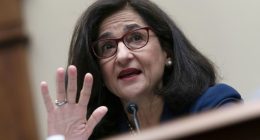
The global economy is showing signs of stronger growth as its factories continued to boom and service providers began to see the benefits of vaccination programs.
After a big contraction in 2020, the global economy is forecast to rebound strongly this year as vaccination programs allow more parts of the services economy to reopen fully. There were already signs of that rebound in the U.S. and China during the early months of the year, but surveys of purchasing managers released Friday indicate that Europe is also starting to participate in the recovery.
Threats to the recovery remain, not least the possibility that new variants of the Covid-19 virus will prove more resistant to vaccinations and more easily transmitted. Restrictions on activity remain in many parts of the world, and India Thursday reported the world’s biggest ever single-day jump in new infections.
Many European countries retain restrictions on services that require close physical proximity and most forms of international travel. But the surveys recorded the first expansion of activity in its dominant services sector since August 2020, while its manufacturing sector continued to enjoy strong growth.
“Although the service sector continued to be hard hit by lockdown measures, it has returned to growth as companies adjust to life with the virus and prepare for better times ahead,” said Chris Williamson, chief business economist at IHS Markit.
The eurozone economy likely contracted in the first three months of the year, reflecting still high infection rates and a slow start to vaccination programs. But the April survey points to a return to growth in the second quarter.
Businesses appear to be preparing for a pickup in activity, with purchasing managers reporting the strongest new hiring since November 2018, driven by factories that saw new orders rise at a record pace.
There are continuing signs that the pace of the global manufacturing recovery was straining supply lines, which may prove to be a drag on growth. In the eurozone, businesses reported the largest rise in waiting times for delivery of supplies in the survey’s 23-year history, while the prices they paid for their inputs rose at the fastest pace in a decade.
Similar surveys from the U.S. later Friday are expected to point to continued strong growth, stretched supply lines and costlier inputs.
Although Europe’s vaccination drives have been beset with supply hiccups and worries over side effects, they have picked up pace in recent weeks and that has made households more hopeful about their prospects. A separate survey by the European Commission released Thursday found that consumer confidence hit a pandemic high in April after a surprisingly sharp rise from March.
In contrast to much of the rest of Europe, the U.K.’s vaccination drive has kept pace with that of the U.S. That has spurred optimism among businesses and households that the country will be able to reopen the large parts of its economy that have been frozen over much of the past year by the end of June.
Some restrictions were lifted in April and that had an immediate impact on growth, with the survey of purchasing managers recording the strongest increase in activity since November 2013.
The surveys also pointed to a pickup in Japan, where activity in the services sector has also been subdued. Indeed, the composite Purchasing Managers Index for the country—which measures activity in the services and manufacturing sector—rose to 50.2 in April from 49.9 in March, pointing to an expansion for the first month since the pandemic struck.
However, a full reopening of the economy remains many months away. The government Thursday said it would re-establish a state of emergency on Sunday in Tokyo and other major cities after crowds came back to urban centers and infections surged again. the emergency in Tokyo, Osaka, Kyoto and the prefecture that includes Kobe would last for 17 days, until May 11, covering the Golden Week holidays in the first week of May.
Australia has contained the pandemic more tightly than Japan and Europe, and the surveys point to strong growth in its economy during April. The composite PMI rose to 58.8 from 55.5 in March, the highest reading since the series began in 2016.
Write to Paul Hannon at [email protected]
Copyright ©2020 Dow Jones & Company, Inc. All Rights Reserved. 87990cbe856818d5eddac44c7b1cdeb8








